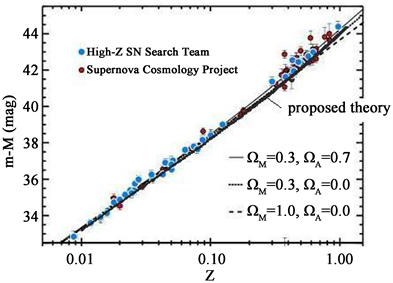1. Introduction
The 100-year-old dominating theory tells that our universe was created about 13.8 billion years ago by a singular Big Bang (BB) [1] . But, the BB theory has many problems [1] . Additionally, recent observations [2] discovered several well developed galaxies with ages too close to the time of conjectural BB [2] . One possibility to resolve this conundrum is to develop a new theory of quick formation and development of galaxies. In this letter we consider another possibility that the BB assumption is wrong.
From the classical Einstein equation of general relativity (GR) [3] follows strict conservation of energy. So, according to this equation, the universe can not be created, it can only exist forever, which was initial opinion of Einstein. But, Freedman obtained dynamical solution of this equation with initial singularity [1] . In response to this, Einstein introduced cosmological constant (CC) to make stationary solution, but later declared CC as his greatest blunder, when observations indicated expansion of the universe. Nevertheless, later CC was used in combination with the assumption of singular BB miracle, which seems to save the situation with GR and observations. Note, that BB was initially coined by Hoyle as a joke, but later it was considered seriously.
2. Quantum Modification of General Relativity (Qmoger)
Physically spiking, singularity of solution indicates, that theory needs some correction. Also, quantum vacuum is hardly consistent with strict conservation of energy [4] . Additionally, CC in the BB theory is ridiculously small. To correct all that, the quantum modification of the general relativity (Qmoger) was initiated [5] . The development and applications of this theory [6] [7] [8] [9] [10] are in good quantitative agreement with cosmic data, including the accelerated expansion, without fitting parameters [see, particularly, Figure 1 and equation (11) in [9] ].
The essence of Qmoger is that the space-time is not only curved (Einstein), but also compressible with corresponding new dynamics of production/absorption of matter/energy by the quantum vacuum [5] [equations (3)-(6) in [9] ]. In Qmoger there is no singular BB, no CC and our universe is much older than in the BB theory. Mathematically, in Qmoger the universe was born infinite time ago [equations (10) and (14) in [9] ]. But physically, the age of the universe is about 327 billion years [8] , when its size reached the Plank length
, where
is the reduced Plank constant, G is the gravitational constant and c is the speed of light in a vacuum. The feeding of the universe by the quantum vacuum is very delicate and local energy conservation is emerging when locally there is sufficient energy, so that additional feeding can be neglected. But, in cosmic time-scales the feeding creates the universe.
Because of the feeding, the universe is the open (non-Hamiltonian) system. All laws are approximate and emerging along with the evolution of universe, with some sort of natural selection in a struggle with various instabilities. Initially, the (3 + 1)-dimensional space-time and ultralight gravitating (dark) matter was selected, as a stable system for the beginning, taking into account that the

Comparison of exact analytical solution [equation (2.10) in [9] ] with results of two observational projects and with some parametrical models (details in Ref. [6] [7] ). Here z = a/a0 − 1 is the Redshift, m and M are apparent and absolute magnitudes of the source correspondingly. The observations are model-independent.
Figure 1. Accelerated expansion.
[1 (or 2) + 1]-dimensional universes are collapsing [11] . Then came quantum interaction (entangled condensate) for additional stability. When the quantum condensate becomes gravitationally unstable [tcr ~ 187.5 billion years ago, see equation (20) and below in [9] ], the ordinary matter (photons, neutrinos and more heavy particles) where selected as an energy relieve from hot spots. In a sense, ordinary matter and we, the people, are a side effect of evolution of the dark universe in a struggle with gravitational instability. The quantum interaction of ordinary matter, apparently, was inherited from the background condensate. From the human point of view, the greatest achievement of the universe (so far) is the subjectivity (qualia), as an interface between quantum (dark) background and ordinary matter in our brain [9] [12] .
3. Conclusions
According to Qmoger [Appendix [9] ], indicated above tcr marks start of forming embryonic stars and galaxies. So, galaxies had plenty of time to fully develop in agreement with observations [2] . We can expect observation of even more earlier galaxies.
The described paradigm has broad spectrum of applications from obvious (cosmology, quantum field theory, energy resources) to less obvious (health [9] [12] , new forms of communications, weapons). Some developed civilizations in the universe may already master this paradigm (with various applications) and so should we.